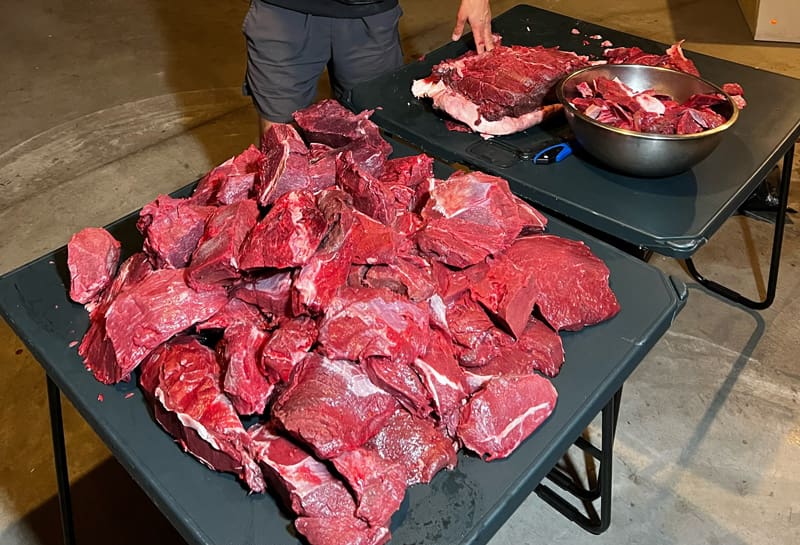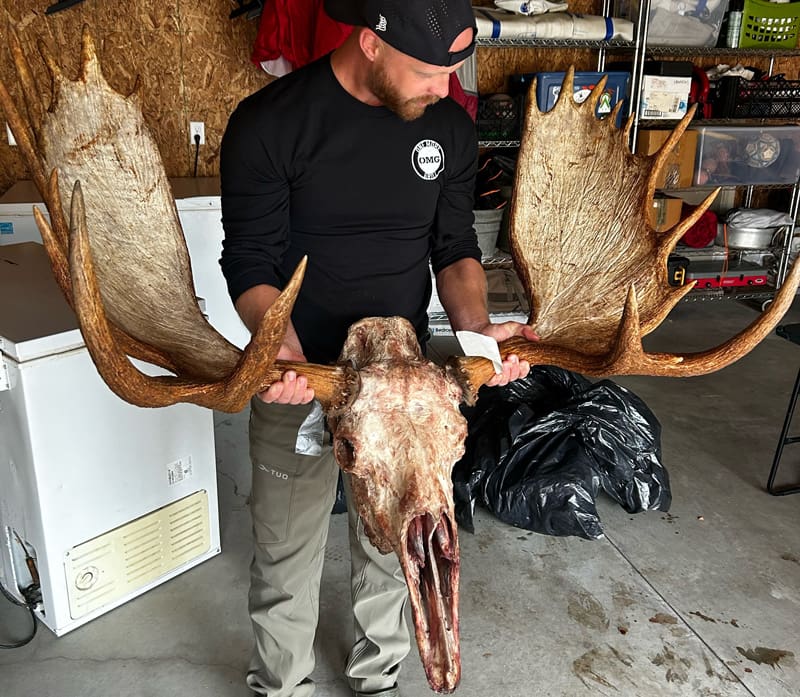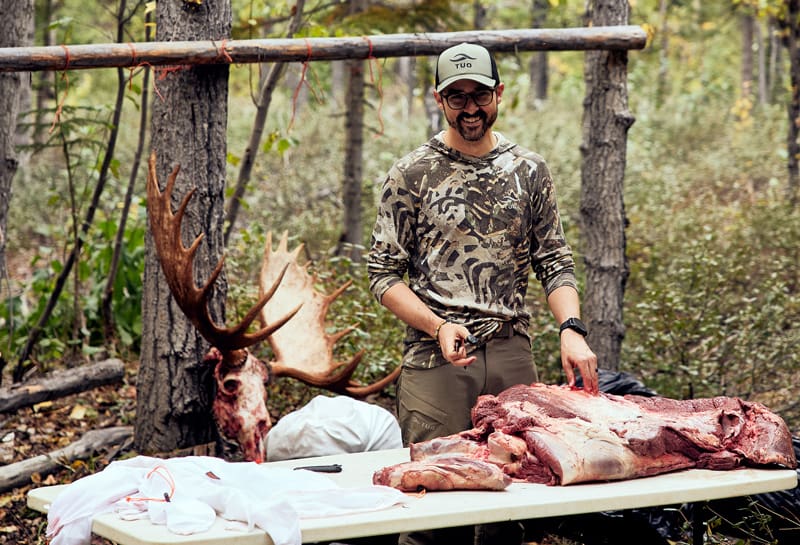Big game processing refers to the series of steps involved in preparing and preserving big game meat for consumption. Whether you are an avid hunter or someone who enjoys the taste of lean and flavorful meat, processing big game is a crucial skill to master. Understanding the entire process and having the right tools and techniques can make the difference between a delicious meal and a disappointing one.
The process of big game processing typically begins with the field dressing and skinning of the animal. After harvesting a big game, it is necessary to remove the internal organs and connective tissues to ensure the meat stays clean and uncontaminated. This step is essential for both hygiene reasons and to prevent the development of nasty flavors.
Once the big game has been field-dressed and skinned, it is time to break down the carcass into manageable cuts of meat. Using a sharp knife, you can separate the hindquarters into different portions, such as rump roasts, stew meat, and steaks. It is important to cut along the natural muscle lines to ensure clean and even cuts.
The big game processing continues by focusing on the rest of the carcass. The neck meat, shoulders, and shank meat can be tenderized and transformed into delicious pot roasts, stews, or ground meat. You can even keep the shoulders whole and make a fantastic barbacoa. By utilizing different cuts of meat, you can create a wide variety of dishes that cater to your taste and preferences.
To preserve the freshness and quality of the meat, it is vital to properly store it. As soon as the meat is cut into individual muscles, it should be chilled in cold water or placed on bags of ice to prevent bacteria growth and maintain its flavor. If you plan to keep the meat for an extended period, vacuum sealing or wrapping it in freezer paper can protect it from freezer burn.
Another crucial aspect of big game processing is allowing the meat to go through rigor mortis before consumption. This natural process ensures the development of tenderness and enhances the flavor of the meat. By hanging the meat in a cool and ventilated area, you allow it to mature and become the best-tasting venison you can enjoy.
Big game processing is a skill that every hunter should have. By understanding the steps involved and using the right tools, you can turn a harvested big game into delicious cuts of meat suitable for different dishes. Remember to always handle the meat clean, have a sharp knife on hand, and make use of proper storage techniques to ensure the meat remains fresh and safe for consumption. With practice and experience, you will become an expert in the butchering process.
Essential Tools Needed For Big Game Processing
When it comes to big game processing, having the right tools at your disposal can make all the difference. These tools not only help you efficiently break down the carcass but also ensure the safety and quality of the meat. Here are some essential tools that every big game processor should have:
1. Sharp Knife: A sharp knife is your best friend throughout the entire process. It allows you to make clean cuts and separate the different cuts of meat with ease. Ensure your knife is sharp enough to avoid any unnecessary strain or accidents. We’ll sharpen regularly throughout the process.
2. Fillet/Surgeon-Style Knife: A fillet knife is a smaller, flexible knife that is perfect for removing connective tissue and skinning the big game. Its thin, sharp blade allows you to navigate around bones and joints effortlessly. The replaceable blade variety is really nice for this stuff. When one dulls, you can just swap them out.
3. Meat Grinder: Grinding up some of the pieces of meat for ground venison or sausages is a popular choice for many big game processors. A reliable meat grinder helps you create consistent textures and sizes, making it easier to incorporate the meat into various recipes. Grinders also enable you to make sure you utilize every bit of meat. Often, butchers will add in pork fat to make up for the leanness of the meat. A general rule of thumb is roughly 10-15% fork fat for venison burger. (Tip: don’t skimp on this tool – bad grinders just eat up time and process sub-optimal quality meat)
4. Bone Saw: As you break down the carcass, you’ll often need to cut through leg bones and the pelvic bone. A bone saw is specifically designed for this purpose, making it easier to separate the meat from the bone. This tool is nice for doing things like osso buco but we have found you can get away with a good nice and sticking to cutting the joints.
5. Vacuum Sealer: To preserve the freshness and extend the shelf life of the processed meat, a vacuum sealer is a must-have. It removes air from the packaging, preventing freezer burn and ensuring the meat remains flavorful and tender.
6. Freezer Paper and Bags: Once the meat is portioned and ready for storage, freezer paper and bags are essential for protecting it from freezer burn. Make sure to label each package with the date to keep track of the meat’s age.
7. Meat Hooks or Meat Pole: Hanging the meat during the aging process is crucial for enhancing flavor and tenderness. Meat hooks or sturdy meat pole provide a designated space for the meat to hang in a cool and ventilated area.
Having these essential tools on hand will streamline the big game processing experience and ensure you can tackle each step with confidence. Remember to always prioritize safety, keeping your tools clean and in good condition, and following proper handling and sanitation practices throughout the process. Happy processing!

Skinning Process
The skinning process is an essential step in butchering a big game and requires some skill and precision. Here are a few tips to help you navigate through this part of the big game processing journey.
First and foremost, it’s crucial to have a sharp knife on hand. A dull knife will make the skinning process tedious and can increase the risk of accidents. Ensure your knife is sharp enough to make clean cuts without exerting too much force.
Start by making a shallow incision around the big game’s hind leg bones, right around the knee. Use your fillet knife to carefully slice through the skin and connective tissue, moving towards the body. Take your time and be gentle to avoid piercing the underlying muscle tissue or damaging the hide.
Once you’ve made the initial incision, grab hold of the skin and pull it away from the carcass while simultaneously cutting through any remaining tissue. Work your way up towards the big game’s belly, keeping the skin taut as you go. This method will help prevent hair and dirt from contaminating the meat.
As you encounter the hindquarters, pay extra attention to the area around the pelvic bone. This can be a tricky spot, but with a little patience and finesse, you’ll be able to navigate around it without compromising the integrity of the meat.
Continue skinning the big game, being mindful of sensitive areas like the shoulder joint and neck meat. These portions may require extra care to avoid any waste or damage.
Once you’ve successfully removed the skin, take a moment to examine it. If there are any patches of hair or dirt remaining, use a clean cloth or towel to gently wipe them away. You can also use a hose or rinsing station to wash the skin thoroughly.
Now that you have a clean and properly skinned big game, proceed with the next steps of the butchering process. Remember to keep the meat clean and cool throughout the entire process by placing it on bags of ice or immersing it in cold water. This will help preserve its freshness and prevent any potential bacterial growth.
With a sharp knife, a steady hand, and a careful approach, you can master the skill of skinning a big game. Take your time, be patient, and embrace the process. Note: this is best done with the big game hanging in a covered place like a garage. However, this isn’t always something that’s available. Often, you’ll be required to do this in the field. If that’s the case, it’s ideal to have a tarp with you, so you can lay it down without getting your meat dirty.

Cutting Up the Meat
Now it’s time to move on to the next step in processing your big game: cutting up the meat. This is where you can really bring out your inner butcher and transform the big game into delicious cuts of meat that can be enjoyed in a variety of dishes.
Before you begin, make sure you have a sharp knife and a clean workspace. A fillet knife or a butcher knife will work well for this task. Start by removing the hindquarters or hind legs of the big game. This is where most of the meat is concentrated, and it can be used for everything from steaks to roasts. Simply make a cut around the leg bone and carefully separate the meat from the bone. Take your time and follow the natural muscle separations with your knife to ensure clean cuts of meat.
Once you have the hindquarters separated, you can further break it down into different cuts. For steaks, slice the meat against the grain to the desired thickness. For roasts, trim any excess fat and connective tissue, and then tie the roast with butcher’s twine for even cooking. The shoulder joint can also be removed and used for stew meat or ground meat. Just be sure to remove any bone fragments and silver skin when processing the meat.
The neck meat is another flavorful and tender part of the big game that is often overlooked. Remove the neck by cutting through the base of the skull and down the neck bone. From there, you can use the neck meat for stews, ground meat, or even bone broth. It’s a versatile cut that adds flavor and richness to any dish.
As you work your way through the big game, don’t forget about the shank meat. Although it can be tough, slow cooking or braising can turn this into a melt-in-your-mouth delicacy. With a little patience, you can transform the shank meat into tender pot roasts or flavorful stews.
Throughout the entire process, it’s important to keep the meat clean and handle it with care. Wash your hands and utensils regularly to prevent cross-contamination. If you need to take a break, place the meat in bags of ice or keep it in a cool environment to prevent spoilage. If you have a vacuum sealer, use it to package and store the meat for longer periods of time. Alternatively, you can use freezer paper to wrap the individual cuts, ensuring that they are well-sealed and protected from freezer burn.
Once all the meat is cut up and stored, take a moment to admire your hard work. You now have pounds of venison ready to be enjoyed in a myriad of recipes. Whether you’re grilling venison steaks, making ground venison, or slow-cooking roasts, you can take pride in knowing that you’ve produced some of the best-tasting venison around.
Remember, the butchering process might seem daunting at first, but with practice, it will become second nature. Don’t be afraid to experiment with different cuts and cooking methods. And if you find yourself needing assistance, don’t hesitate to reach out to a local butcher shop or experienced hunters who can offer guidance and tips. The satisfaction of processing your own wild game, just like grass-fed beef, is unparalleled. So roll up your sleeves, sharpen your knife, and enjoy the rewarding process of cutting up big game meat.

Deeper Dive: Using a Sharp Knife to Cut Through Muscle Tissue and Tendon Connective Tissues
When it comes to processing big game, having a sharp knife is absolutely crucial. A dull knife can make the task more difficult and even dangerous. A sharp knife, on the other hand, will cut through muscle tissue and tendon connective tissues like butter, making the butchering process much smoother.
Before starting, ensure that your knife is sharp. Sharpen it with a knife sharpener or sharpening stone if needed. A sharp knife will make clean cuts, minimizing damage to the meat and maximizing the amount of usable meat you harvest from the big game.
As you begin cutting through the hindquarters or hind legs of the big game, you will encounter muscle tissue and tendon connective tissues. These tissues are what give the meat its structure and texture. To ensure clean cuts, it’s important to understand the anatomy and follow the natural separations of the muscle groups.
Using a sharp knife, make strategic cuts around the muscle groups, being careful not to waste any of the precious meat. As you cut through the connective tissues, pay attention to the direction of the fibers. Cutting against the grain will help make the meat more tender when cooked.
When encountering tendon connective tissues, it’s essential to cut through them cleanly. This can be done by using the tip of your sharp knife and gently separating the meat from the tendons. By doing this, you ensure that there are no chewy or tough parts in your final cuts of meat.
Connective tissues can also be found within the meat itself in the form of thin white strips or membranes. These can be removed with the tip of your knife, ensuring that your meat is as clean and tender as possible.
Handling a sharp knife may seem intimidating, but with practice and proper technique, it can become a valuable tool in the big game processing process. Always hold the knife with a firm grip and keep your fingers away from the blade. Make sure to cut in a controlled and deliberate manner, keeping the knife parallel to the surface you’re cutting on.
Remember, safety should always be a priority. Take breaks when needed to rest your hand and avoid fatigue or accidental slips. If you feel your knife becoming dull during the process, take the time to sharpen it again before continuing to ensure the best results. By using a sharp knife to cut through muscle tissue and tendon connective tissues, you’ll not only make the butchering process easier and more efficient but also ensure that the meat you yield is of the highest quality. Plus, it will make the overall cooking experience more enjoyable by providing tender and flavorful cuts of venison.
Deeper Dive: Trimming Excess Fat From Each Piece of Meat
When processing big game meat, it’s important to trim excess fat from each piece of meat to enhance its flavor and texture. Trimming excess fat not only improves the taste but also reduces the overall fat content, making the meat leaner and healthier to consume.
To begin, lay out the cuts of meat on a clean cutting board or work surface. Examine each piece carefully and identify any visible fat deposits. These fatty areas can be easily distinguished by their white or yellow color and softer texture.
Using a sharp fillet knife, carefully trim away the excess fat. Start by making small, controlled cuts, working your way around the edges of the fat deposits. Be careful not to remove too much meat along with the fat. Take your time and focus on making clean, precise cuts.
Trimming excess fat is particularly important when it comes to venison, as big game meat can sometimes have a stronger flavor compared to other types of meat. By removing the fatty areas, you can help reduce any lingering gaminess and create a more desirable taste.
Aside from improving flavor, trimming excess fat also prevents any unpleasant greasiness in your dishes. Excessive fat can melt during cooking and result in unappetizing textures or greasy sauces. By removing the fat before cooking, you ensure a more enjoyable and refined eating experience.
Once you have trimmed the excess fat from each piece of meat, it’s a good idea to save the trimmed fat for other uses. Big game fat, also known as tallow, can be rendered down to make cooking oils or used in making homemade beauty products like soaps or salves. Just make sure to properly label and store any leftover fat in your freezer for future use.
Trimming excess fat from each piece of meat is an essential step in the big game processing process. It improves the overall quality of the meat, enhances its taste, and provides a healthier option for those conscious of their fat intake. So, take the time to trim away those unwanted fatty deposits and enjoy the clean, lean meat that is the result of your efforts.

Processing Yourself is Worth It
Become a master of big game processing, a vital skill for every hunter. Unlock the secret to transforming a freshly hunted big game into mouthwatering cuts of meat that will tantalize your taste buds in a variety of delectable dishes. Level up your meat game by mastering the art of cleanliness, equipping yourself with a wickedly sharp knife, and unleashing the power of proper storage to guarantee the freshest and safest meat experience. With enough practice and a touch of experience, you’ll soon be wielding your butchering skills like a true master of the craft.
